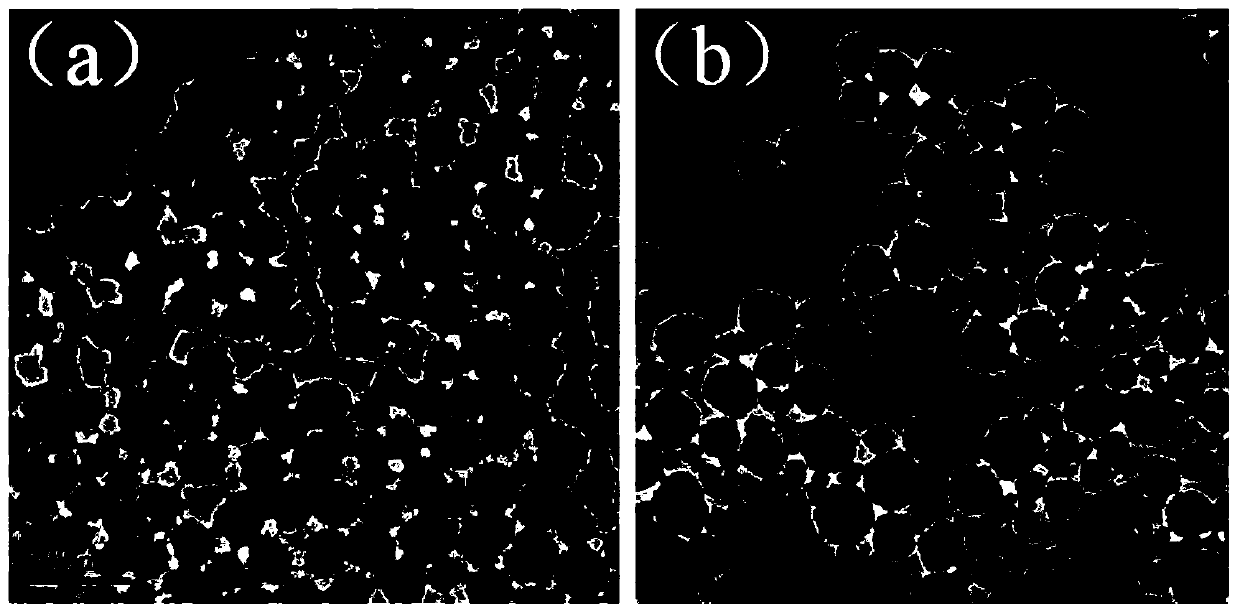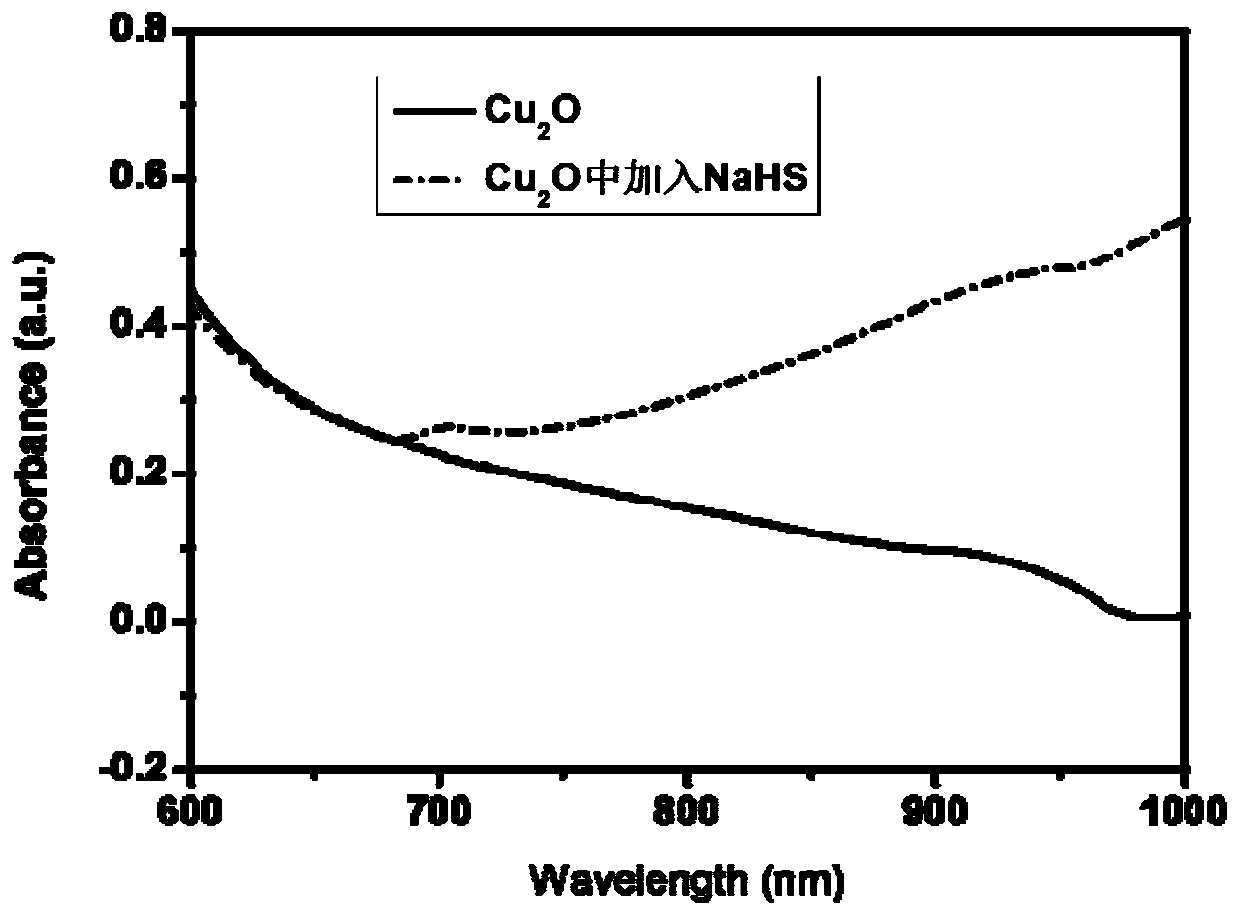Synthesis of Cuprous Oxide Materials and Its Application in Photoacoustic Detection of Sulfides
A technology of cuprous oxide and technical detection, applied in the direction of copper oxide/copper hydroxide, nanotechnology, analytical materials, etc., to achieve the effect of strong binding ability, good stability and easy operation
- Summary
- Abstract
- Description
- Claims
- Application Information
AI Technical Summary
Problems solved by technology
Method used
Image
Examples
Embodiment 1
[0040] (1) First weigh 1.0 g of polyvinylpyrrolidone, add 10 mL of nitrogen-methylpyrrolidone to dissolve and disperse, wait until the solution becomes clear and transparent, add 3.0 g of copper nitrate solid under magnetic stirring, and continue stirring for 10 minutes to obtain a green transparent solution;
[0041] (2) The above solution was heated to 200° C. in a heating magnetic stirrer, and the magnetic stirring was carried out for 60 minutes;
[0042] (3) After the reaction, through centrifugal purification and redispersion in secondary water, the final product polyvinylpyrrolidone-coated cuprous oxide nanoparticles (i.e. nano-photoacoustic probes or cuprous oxide-based materials) can be obtained. The particle size is 80nm.
[0043] (4) Take the nano-photoacoustic probe and redisperse it in phosphate buffered saline PBS at a concentration of 50 micrograms per milliliter. Using a photoacoustic instrument, test the photoacoustic intensity before and after adding sodium hy...
Embodiment 2
[0053] (1) First weigh 1.0g of polyvinylpyrrolidone, add 10mL of nitrogen-methylpyrrolidone to dissolve and disperse, wait until the solution becomes clear and transparent, add 1.0g of copper nitrate solid under magnetic stirring, and continue stirring for 10 minutes to obtain a green transparent solution;
[0054] (2) The above solution was heated to 200° C. in a heating magnetic stirrer, and the magnetic stirring was carried out for 60 minutes;
[0055] (3) After the reaction, through centrifugal purification and redispersion in secondary water, the final product polyvinylpyrrolidone-coated cuprous oxide nanoparticles (i.e. nano-photoacoustic probes or cuprous oxide-based materials) can be obtained. The particle size is 50nm.
[0056] (4) Redisperse the nano-photoacoustic probe in secondary water with a concentration of 50 micrograms per milliliter. Using a photoacoustic instrument, test the photoacoustic intensity before and after adding sodium hydrosulfide, and the photoac...
Embodiment 3
[0059] (1) First weigh 1.0 g of polyvinylpyrrolidone, add 10 mL of nitrogen-methylpyrrolidone to dissolve and disperse, wait until the solution becomes clear and transparent, add 2.0 g of copper nitrate solid under magnetic stirring, and continue stirring for 10 minutes to obtain a green transparent solution;
[0060] (2) The above solution was heated to 200° C. in a heating magnetic stirrer, and the magnetic stirring was carried out for 60 minutes;
[0061] (3) After the reaction, through centrifugal purification and redispersion in secondary water, the final product polyvinylpyrrolidone-coated cuprous oxide nanoparticles (i.e. nano-photoacoustic probes or cuprous oxide-based materials) can be obtained. The particle size is 200nm.
[0062] (4) The nano-photoacoustic probe was redispersed in phosphate buffered saline PBS at a concentration of 50 micrograms per milliliter. Using a photoacoustic instrument, the photoacoustic intensity before and after adding sodium hydrosulfide ...
PUM
| Property | Measurement | Unit |
|---|---|---|
| particle diameter | aaaaa | aaaaa |
| particle diameter | aaaaa | aaaaa |
| particle diameter | aaaaa | aaaaa |
Abstract
Description
Claims
Application Information
 Login to View More
Login to View More - R&D
- Intellectual Property
- Life Sciences
- Materials
- Tech Scout
- Unparalleled Data Quality
- Higher Quality Content
- 60% Fewer Hallucinations
Browse by: Latest US Patents, China's latest patents, Technical Efficacy Thesaurus, Application Domain, Technology Topic, Popular Technical Reports.
© 2025 PatSnap. All rights reserved.Legal|Privacy policy|Modern Slavery Act Transparency Statement|Sitemap|About US| Contact US: help@patsnap.com



